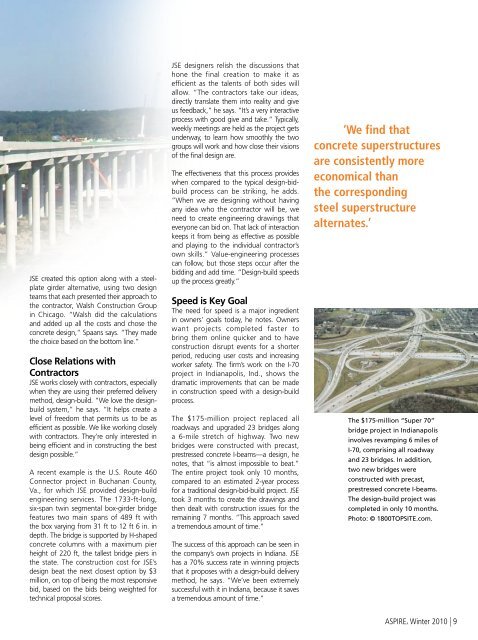ASPIRE Winter 10 - Aspire - The Concrete Bridge Magazine
ASPIRE Winter 10 - Aspire - The Concrete Bridge Magazine
ASPIRE Winter 10 - Aspire - The Concrete Bridge Magazine
You also want an ePaper? Increase the reach of your titles
YUMPU automatically turns print PDFs into web optimized ePapers that Google loves.
JSE created this option along with a steelplate<br />
girder alternative, using two design<br />
teams that each presented their approach to<br />
the contractor, Walsh Construction Group<br />
in Chicago. “Walsh did the calculations<br />
and added up all the costs and chose the<br />
concrete design,” Spaans says. “<strong>The</strong>y made<br />
the choice based on the bottom line.”<br />
Close Relations with<br />
Contractors<br />
JSE works closely with contractors, especially<br />
when they are using their preferred delivery<br />
method, design-build. “We love the designbuild<br />
system,” he says. “It helps create a<br />
level of freedom that permits us to be as<br />
efficient as possible. We like working closely<br />
with contractors. <strong>The</strong>y’re only interested in<br />
being efficient and in constructing the best<br />
design possible.”<br />
A recent example is the U.S. Route 460<br />
Connector project in Buchanan County,<br />
Va., for which JSE provided design-build<br />
engineering services. <strong>The</strong> 1733-ft-long,<br />
six-span twin segmental box-girder bridge<br />
features two main spans of 489 ft with<br />
the box varying from 31 ft to 12 ft 6 in. in<br />
depth. <strong>The</strong> bridge is supported by H-shaped<br />
concrete columns with a maximum pier<br />
height of 220 ft, the tallest bridge piers in<br />
the state. <strong>The</strong> construction cost for JSE’s<br />
design beat the next closest option by $3<br />
million, on top of being the most responsive<br />
bid, based on the bids being weighted for<br />
technical proposal scores.<br />
JSE designers relish the discussions that<br />
hone the final creation to make it as<br />
efficient as the talents of both sides will<br />
allow. “<strong>The</strong> contractors take our ideas,<br />
directly translate them into reality and give<br />
us feedback,” he says. “It’s a very interactive<br />
process with good give and take.” Typically,<br />
weekly meetings are held as the project gets<br />
underway, to learn how smoothly the two<br />
groups will work and how close their visions<br />
of the final design are.<br />
<strong>The</strong> effectiveness that this process provides<br />
when compared to the typical design-bidbuild<br />
process can be striking, he adds.<br />
“When we are designing without having<br />
any idea who the contractor will be, we<br />
need to create engineering drawings that<br />
everyone can bid on. That lack of interaction<br />
keeps it from being as effective as possible<br />
and playing to the individual contractor’s<br />
own skills.” Value-engineering processes<br />
can follow, but those steps occur after the<br />
bidding and add time. “Design-build speeds<br />
up the process greatly.”<br />
Speed is Key Goal<br />
<strong>The</strong> need for speed is a major ingredient<br />
in owners’ goals today, he notes. Owners<br />
want projects completed faster to<br />
bring them online quicker and to have<br />
construction disrupt events for a shorter<br />
period, reducing user costs and increasing<br />
worker safety. <strong>The</strong> firm’s work on the I-70<br />
project in Indianapolis, Ind., shows the<br />
dramatic improvements that can be made<br />
in construction speed with a design-build<br />
process.<br />
<strong>The</strong> $175-million project replaced all<br />
roadways and upgraded 23 bridges along<br />
a 6-mile stretch of highway. Two new<br />
bridges were constructed with precast,<br />
prestressed concrete I-beams—a design, he<br />
notes, that “is almost impossible to beat.”<br />
<strong>The</strong> entire project took only <strong>10</strong> months,<br />
compared to an estimated 2-year process<br />
for a traditional design-bid-build project. JSE<br />
took 3 months to create the drawings and<br />
then dealt with construction issues for the<br />
remaining 7 months. “This approach saved<br />
a tremendous amount of time.”<br />
<strong>The</strong> success of this approach can be seen in<br />
the company’s own projects in Indiana. JSE<br />
has a 70% success rate in winning projects<br />
that it proposes with a design-build delivery<br />
method, he says. “We’ve been extremely<br />
successful with it in Indiana, because it saves<br />
a tremendous amount of time.”<br />
‘We find that<br />
concrete superstructures<br />
are consistently more<br />
economical than<br />
the corresponding<br />
steel superstructure<br />
alternates.’<br />
<strong>The</strong> $175-million “Super 70”<br />
bridge project in Indianapolis<br />
involves revamping 6 miles of<br />
I-70, comprising all roadway<br />
and 23 bridges. In addition,<br />
two new bridges were<br />
constructed with precast,<br />
prestressed concrete I-beams.<br />
<strong>The</strong> design-build project was<br />
completed in only <strong>10</strong> months.<br />
Photo: © 1800TOPSITE.com.<br />
<strong>ASPIRE</strong>, <strong>Winter</strong> 20<strong>10</strong> | 9

















